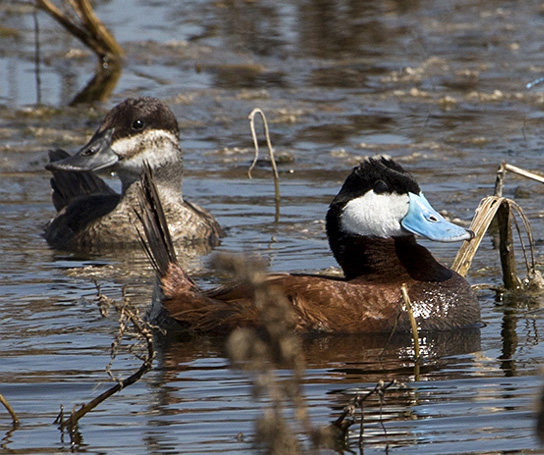By John Shackford

The Ruddy Duck (Oxyura jamaicensis) is something of an odd duck (as the saying goes); it is a diving duck species. The genus name Oxyura means sharp tailed because they often hold their tails stiffly upright while on the water. Breeding males are easy to identify because they have white cheek patches, combined with a bright ruddy brown body and a striking blue bill. Winter males are not nearly so ruddy in color, a more darkish grey or black body. Females and young birds are relatively easy to identify; they have a dark body with white cheeks that have a dark horizontal line through the white face.
Generally speaking, ruddies winter in the southeastern U.S. They are usually regular in winter from northern Texas southward well into Mexico. This species is quite regular on the Oklahoma City Christmas Bird Count (CBC); the last time we did not record them was 1993. Looking back on the historical record of our CBC, they were seen off and on in quite small numbers, starting from 1951 (our count probably does not go back much, if any, before this year) until 1996. From 1993 until 2003, there was a significant uptick until we reached our highest number per party hour of 3.5 birds in 2003. Since then they have shown a prolonged decline until 2016. It is unclear what this decline is due to; have overall populations in our area been declining faster than climate change has brought them northward? If so, this is against the trend of many other bird species as it relates to climate change.
As for nesting in the state, I found possible nesting birds in a Boise City (Cimarron County) sewer pond in 1978. As to why I was wading around in a sewer pond in Cimarron County I will only say some young people will do most anything for a new state record!
The circumstances were interesting. On 6 June 1978 I found what I believed to be a Ruddy Duck nest that held 5 eggs in cattails at the sewer pond. No bird was on the nest but when I returned the next day, I thought I heard a bird—unseen—slide into the water. Not long thereafter I saw a female Ruddy Duck some distance away and moving directly away from the nest. I thought the eggs were rather large for a ruddy. Later, reading about ruddy eggs, I learned that Ruddy Ducks have surprisingly large eggs for such a small duck.
But the best part of the story for me came the next year, starting on 28 June 1979: Brooks and Thula Parkhill, former members of our club, reported that they saw a female Ruddy Duck, with six young on the sewer pond.
I very much wanted to get a verifying photo. Likely through trial and error over the next two days, we learned that the female and young “roosted” at night in a thin growth of (noncattail) water plants near shore, and that they could be found there early in the morning, but if you were not early, the ruddies would move well out from shore in the sewer pond.
To complicate the problem of getting a decent photo, I was with several other people and did not want to inconvenience them as I tried to get a picture. So on 30 June 1979, while everyone else went about breakfast, etc. at a nearby motel, I slipped away for a few minutes to try to get a photo of the ruddies, before they left the thin vegetation.
The day was clear and I arrived at the sewer pond early in the morning, when it still was not very light. I came up over the side of the sewer pond and the ruddies were right where I had hoped they would be—still close to shore in the thin vegetation. As they started swimming toward the middle of the pond, I got my picture, but the contrast of the picture was very low. This was at a time when I was developing and printing black-and-white photos on my own.
To the best of my ability, I tried to get the best contrast I could through darkroom “tricks”, but the photo still was not very good. It became, however, the front page picture of the June 1980 issue of the Bulletin of the Oklahoma Ornithological Society, representing unequivocal documentation of nesting Ruddy Ducks for the state. This may be the worst picture I ever had used for a publication, but, given all the obstacles I had faced in getting the picture in the first place, I still remain rather proud of it.
